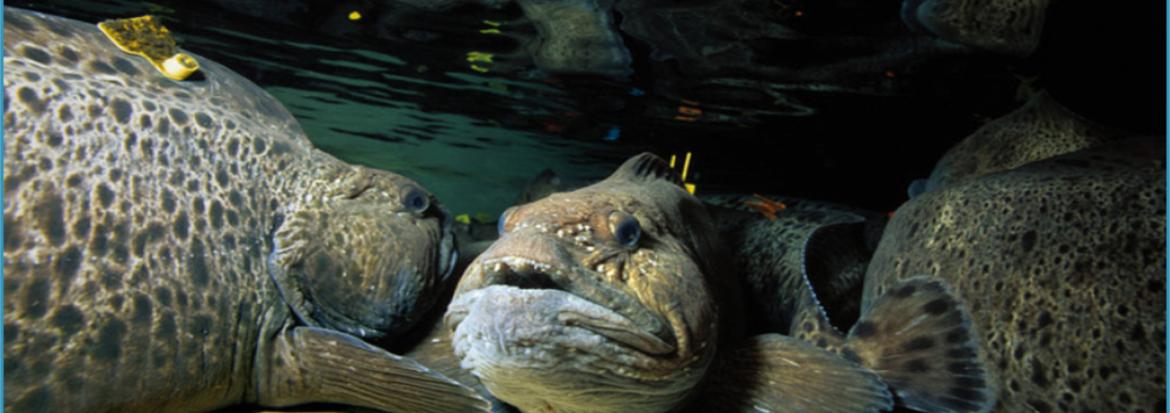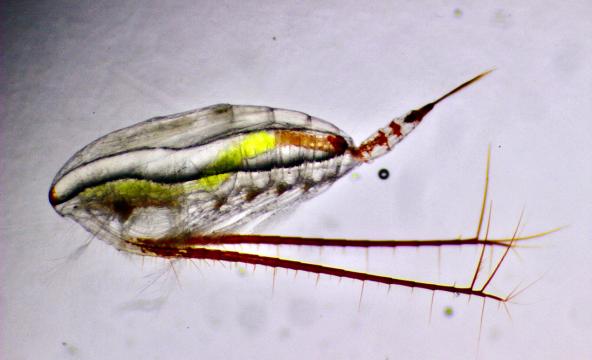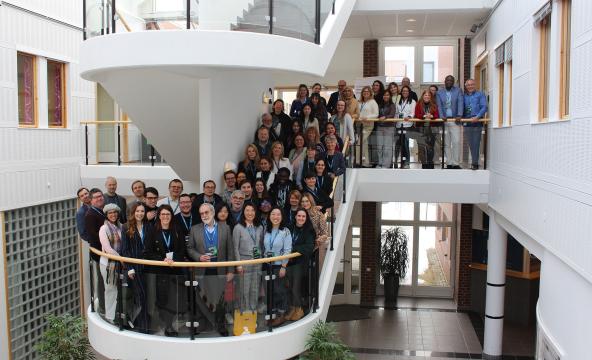
"There is a period where we can see that their bellies just keep growing. In the end, it looks like they have a small basketball in their stomach."
This indeed sounds like a familiar pregnancy progression. But what researcher Jose Beirao is describing are the spawning-ready females of the species Anarhichas minor, also known as spotted wolffish.
"Gradually, we see them start lying on their side. They need to be monitored daily. About eight hours before spawning, we can begin to see signs, such as contractions."
Raised in what can be described as the shoreline rocks of the coast of Portugal, a fascination with marine life led him to the University of Leon in Spain and a Ph.D. in fish reproductive biology. Eight years ago, he arrived in Bodø at the Faculty of Biosciences and Aquaculture at Nord University and began working with spotted wolffish, considered a promising candidate for aquaculture since the nineties.
"In its natural habitat, out at sea, the wolffish makes a nest. It doesn't do this when in captivity. In the wild, the male will guard the eggs after they have been laid. He rocks them so that they stick together like a ball and watches over them until they hatch," says Beirao.

Easy to Control
Not only is the male wolffish a caring father, but he also appears to be a passionate lover. Unlike other marine fish such as cod and halibut, wolffish have internal fertilization. When the female is ready to spawn, and the eggs starts moving towards the female's genital opening, the male lays over the female and fertilizes the eggs while they are still inside her.
In the wild, the male will guard the eggs after they have been spawned. He rocks them around so that they stay together like a ball and watches over them until they hatch.
Jose Beirao
If the sperm comes into contact with seawater, the sperm cells lose mobility, preventing fertilization. This creates challenges for those wanting to farm the species.
"In captivity, this behavior is disrupted. The female will spawn the eggs into the water without them being fertilized. This is a challenge with wolffish, as it makes it complicated to produce new fish. But it's also an advantage because it gives us very good control," says Beirao.
At Nord University, Beirao has developed procedures for long-term storage of wolffish sperm and controlled egg fertilization.
"Some males can have sperm all year round, although the quality improves as the spawning season approaches, and one can collect sperm from the same male several times throughout the spawning season. The female, on the other hand, spawns only once a year, sometimes only every other year."
Watch the Female with Argus Eyes
Being able to store sperm from the males effectively is thus essential for achieving a stable production of wolffish in aquaculture.
"Often, storage reduces the quality of the sperm cells, resulting in a lower fertilization rate. Here in Bodø, we have therefore developed a technique for freezing wolffish sperm in liquid nitrogen in large volumes, adapted to the industry's needs," says Beirao.
Producing wolffish fry is a labor-intensive project. However, the gain is high if successful. Beirao has a lot of trial and error behind him in working on artificial insemination of wolffish in captivity, a process that must run smoothly to farm the species successfully.
"When the females were ready, we had to monitor them continuously, since we had to get the eggs just before they went into the water. We could see that it was just before they were going to spawn when the genital opening began to open. When the opening was between five and seven centimeters, a fluid would begin to come out, ovarian fluid. We let the fish lie in the tank with a mirror underneath, and the slightly sticky ovarian fluid, which is more viscous than the seawater, would then be visible in the mirror. That was the moment when we could take the fish out of the tank and strip it for eggs," Beirao recounts.

Robust as Newborns
A female weighing five to six kilos can produce between one and two liters of eggs. This provides between 5,000 and 10,000 eggs.
"The good thing about wolffish is, if the quality of the gametes is good and incubation goes without mishap, we achieve very high survival rates for the eggs, around 90 percent."
When the larvaes hatch, they are between 20 and 25 millimeters long. They have a fully developed digestive system and can be fed with dry food, without the use of live copepods as a starter feed. But first, the eggs need to be well taken care of. Just as diligently as a loving wolffish father would do in the sea.
"Wolffish have a relatively long incubation period. At a water temperature of six degrees, they need about five months to mature. During this period, the eggs must be monitored daily. Dead eggs must be removed immediately to avoid them beginning to rot and fungus spreading to healthy eggs. This is a sensitive phase, but if done correctly, a large number of new young fish that grow quickly will be produced," says Beirao.
Spotted wolffish has been regarded as a promising aquaculture species for many years.
Jose Beirao
He emphasizes that he has not worked with wolffish in recent years and reserves the right that new knowledge on the subject may have emerged. Group leader Ørjan Hagen at the Faculty of Biosciences and Aquaculture says that Nord University has ongoing projects related to wolffish and that interested parties are welcome to contact them for more information.
Need More Commercial Players
"Spotted wolffish has been designated as a promising species for aquaculture for many years," says Hagen.
Commercial farming of the species has been attempted several times. Still, very few commercial players are betting on spotted wolffish. However, at Halsa in Nordland, the company Aminor has now progressed to the point where they can send fresh wolffish to the market weekly. CEO Håvard Olaisen says the research at Nord University is essential for the development of the industry.
"The research from Nord University is crucial for our development, where we have a close and good cooperation. A few players are taking a more significant initiative, and there is a need for more players on the commercial side of farming wolffish," says Olaisen.
Hagen believes there will be a need for further research on the species before we see a real commercial breakthrough for the farming of spotted wolffish.
"We need knowledge about reproduction, feed, and preventive health to ensure a robust fish with rapid growth. However, wolffish are a grateful species in aquaculture. The larvae are large and therefore are started directly on formulated feed, unlike other marine species, like cod, which must be started on live feed," says Hagen.
He believes more commercial players need to step in to create a larger market with stable production to be able to offer a very good product, like the spotted wolffish, to a larger market.
"The Faculty of Biosciences and Aquaculture hopes to secure funding for new research projects so that we can contribute to even more research-based knowledge about spotted wolffish. This is important to be successful with this species in aquaculture."
Reference:
Jose Beirao et al.: Spotted wolffish (Anarhichas minor) sperm cryopreservation in 5-mL cryovials. Fish Physiol Biochem, 2021. Summary. DOI: 10.1007/s10695-020-00837-1








